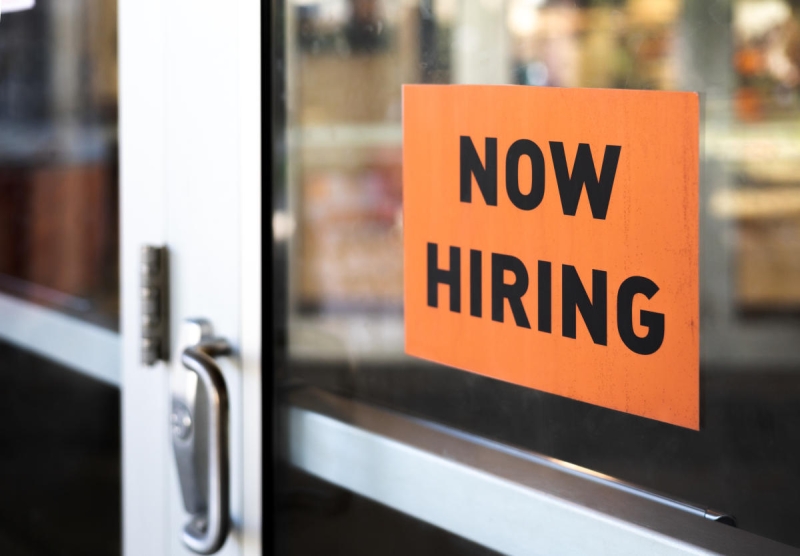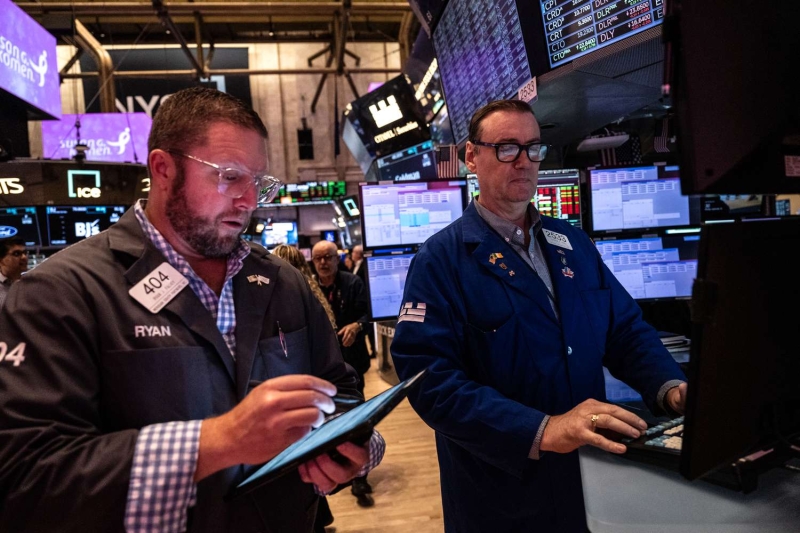
The stock market climbed to all-time highs, with the S&P 500 setting a closing high of 5,762.48 on Monday. For the week, the S&P rose 0.2% to end at 5,751.07. The index is now up 20.6% year to date and up 60.4% from its October 12, 2022 closing low of 3,577.03.
On Friday, we learned the U.S. economy created a healthy 254,000 net new jobs in September. While the number confirms that the labor market isn’t falling apart, the pace of net job creation has cooled from levels seen earlier in this economic cycle.
One labor market indicator that’s been drawing more attention lately is the hiring rate. In addition to measuring those hired into newly created jobs, this metric also captures those hired into existing jobs vacated by quitters, fired workers, and others. It’s been trending lower, and it could be a sign of problems to come.
According to the Job Openings and Labor Turnover Survey (JOLTS) report, employers hired 5.32 million workers in August. While hires far exceed the 1.61 million people laid off during the period, the hiring rate — the number of hires as a percentage of the employed workforce — has fallen to 3.1%, matching the lowest level of the current economic cycle.
As we’ve been discussing for a while, the layoff rate has remained depressed, trending at around 1%, which is below prepandemic levels. That’s a good thing.
But with labor market tailwinds fading, we should be at least a little wary about resting on the economy’s low layoff laurels.
“The hiring rate turns BEFORE layoffs,” Renaissance Macro’s Neil Dutta explained in a research note on Tuesday.
When you think about how well-managed companies operate, this makes sense.
Managers know that a hiring freeze isn’t great news
When the economic tides begin to go out, companies usually don’t go from hiring people one month to immediately sending workers to the unemployment office in the next month.
Unless you’re facing a major business or economic calamity, you probably don’t want to take a hatchet to the headcount. Because what if business activity quickly turns around and you need those workers?
For starters, companies can reduce or freeze hiring, which means not filling new job openings or backfilling roles vacated by former employees. It’s a relatively easy way to keep expenses contained.
If challenges persist, then layoffs could be the next option.
It’s worth mentioning that layoff activity does not need to increase for the unemployment rate to rise. Think about it. Even when the economy is booming, many people are getting laid off every month — but many will quickly go back to work if hiring activity is strong. If the same number of people get laid off into an economy with weakening hiring activity, then more jobseekers will not be able to get back to work, and unemployment rises.
Stay vigilant
The JOLTS survey — which provides data on job openings, hiring activity, layoffs, and quits — can be helpful in predicting what’s to come for the major headline economic metrics like net job creation, the unemployment rate, and inflation.
For example, when the level of job openings posted by employers is high and rising, then you can expect payroll employment to rise and the unemployment rate to fall or stay low. An elevated quits rate could be a reflection of worker confidence in a labor market with increasingly competitive wages, which is a sign that inflation is on the rise.
Today, with the labor market cooling but the layoff rate still depressed, the JOLTS metric to watch right now may be the falling hiring rate.
The question now is whether the economy, now aided by the Federal Reserve, will develop in a way that helps stabilize or improve the hiring rate. Friday’s news that the U.S. continues to create jobs at a healthy pace is encouraging.
And to be crystal clear, most metrics point to a strong economy that continues to grow at a healthy clip. In fact, the hiring rate today is higher than where it was during much of the 2009-2020 economic expansion. Our discussion today is not about sounding alarms. However, we should always be mindful of the fact that economic downturns do happen. And those downturns often come with early warning signs.
Reviewing the macro crosscurrents
There were a few notable data points and macroeconomic developments from last week to consider:
The labor market continues to add jobs. According to the BLS’s Employment Situation report released Friday, U.S. employers added 254,000 jobs in September. It was the 45th straight month of gains, reaffirming an economy with growing demand for labor.
Total payroll employment is at a record 159.1 million jobs, up 6.8 million from the prepandemic high.
The unemployment rate — that is, the number of workers who identify as unemployed as a percentage of the civilian labor force — declined to 4.1% during the month. While it continues to hover near 50-year lows, the metric is near its highest level since October 2021.
While the major metrics continue to reflect job growth and low unemployment, the labor market isn’t as hot as it used to be.
Wage growth ticks up. Average hourly earnings rose by 0.4% month-over-month in September, up from the 0.5% pace in August. On a year-over-year basis, this metric is up 4.0%.
Job openings rise. According to the BLS’s Job Openings and Labor Turnover Survey, employers had 8.04 million job openings in August, up from 7.71 million in July. While this remains slightly above prepandemic levels, it’s down significantly from the March 2022 high of 12.18 million.
During the period, there were 7.12 million unemployed people — meaning there were 1.13 job openings per unemployed person. Once a sign of excess demand for labor, this telling metric is now below prepandemic levels.
Layoffs remain depressed. Employers laid off 1.61 million people in August. While challenging for all those affected, this figure represents just 1.0% of total employment. This metric continues to trend near pre-pandemic low levels.
Hiring activity, while cooling, continues to be much higher than layoff activity. During the month, employers hired 5.32 million people, down from 5.42 million in July.
People are quitting less. In August, 3.08 million workers quit their jobs. This represents 1.9% of the workforce. It continues to move below the prepandemic trend.
A low quits rate could mean a number of things: more people are satisfied with their job; workers have fewer outside job opportunities; wage growth is cooling; productivity will improve as fewer people are entering new unfamiliar roles.
Job switchers still get better pay. According to ADP, which tracks private payrolls and employs a different methodology than the BLS, annual pay growth in September for people who changed jobs was up 6.6% from a year ago. For those who stayed at their job, pay growth was 4.7%.
Unemployment claims tick higher. Initial claims for unemployment benefits rose to to 225,000 during the week ending September 28, down from 219,000 the week prior. This metric continues to be at levels historically associated with economic growth.
Card spending data is holding up. From JPMorgan: “As of 25 Sep 2024, our Chase Consumer Card spending data (unadjusted) was 0.6% above the same day last year. Based on the Chase Consumer Card data through 25 Sep 2024, our estimate of the U.S. Census September control measure of retail sales m/m is 0.13%.“
Gas prices fall. From AAA: “Despite literal and figurative storm clouds here and abroad, the national average for a gallon of gas still fell by three cents from last week to $3.19. The devastation wrought by Hurricane Helene did little to impact gasoline supply, but it crushed demand in affected areas by destroying infrastructure and causing power outages.”
Mortgage rates tick higher. According to Freddie Mac, the average 30-year fixed-rate mortgage rose to 6.12%, up from 6.08% last week. From Freddie Mac: “The decline in mortgage rates has stalled due to a mix of escalating geopolitical tensions and a rebound in short-term rates that indicate the market’s enthusiasm on rate cuts was premature. Zooming out to the bigger picture, mortgage rates have declined one and a half percentage points over the last 12 months, home price growth is slowing, inventory is increasing, and incomes continue to rise. As a result, the backdrop for homebuyers this fall is improving and should continue through the rest of the year.”
There are 146 million housing units in the U.S., of which 86 million are owner-occupied and 39% of which are mortgage-free. Of those carrying mortgage debt, almost all have fixed-rate mortgages, and most of those mortgages have rates that were locked in before rates surged from 2021 lows. All of this is to say: Most homeowners are not particularly sensitive to movements in home prices or mortgage rates.
Construction spending ticks lower. Construction spending declined 0.1% to an annual rate of $2.13 trillion in August.
Manufacturing surveys don’t look great. From S&P Global’s September U.S. Manufacturing PMI: “The September PMI survey brings a whole slew of disappointing economic indicators regarding the health of the US economy. Factories reported the largest monthly drop in production for 15 months in response to a slump in new orders, in turn driving further reductions in employment and input buying as producers scaled back operating capacity.”
Similarly, the ISM’s September Manufacturing PMI signaled contraction in the industry.
Keep in mind that during times of perceived stress, soft survey data tends to be more exaggerated than hard data.
Services surveys look great. From S&P Global’s September Services PMI: “U.S. service sector businesses reported a strong end to the third quarter, with output continuing to grow at one of the fastest rates seen over the past two-and-a-half years. After GDP rose at a 3.0% rate in the second quarter, a similar strong performance looks likely in the three months to September. Encouragingly, inflows of new business in the service sector grew at a rate only marginally shy of August’s 27-month high. Lower interest rates have already been reported by survey contributors as having buoyed demand, notably for financial services which, alongside healthcare, remains an especially strong performing sector.”
Near-term GDP growth estimates remain positive. The Atlanta Fed’s GDPNow model sees real GDP growth climbing at a 2.5% rate in Q3:
Putting it all together
We continue to get evidence that we are experiencing a bullish “Goldilocks” soft landing scenario where inflation cools to manageable levels without the economy having to sink into recession.
This comes as the Federal Reserve continues to employ very tight monetary policy in its ongoing effort to get inflation under control. More recently, with inflation rates having come down significantly from their 2022 highs, the Fed has taken a less hawkish stance in recent months — even cutting interest rates.
It would take more rate cuts before we’d characterize monetary policy as being loose or even neutral, which means we should be prepared for relatively tight financial conditions (e.g., higher interest rates, tighter lending standards, and lower stock valuations) to linger. All this means monetary policy will be relatively unfriendly to markets for the time being, and the risk the economy slips into a recession will be relatively elevated.
At the same time, we also know that stocks are discounting mechanisms — meaning that prices will have bottomed before the Fed signals a major dovish turn in monetary policy.
Also, it’s important to remember that while recession risks may be elevated, consumers are coming from a very strong financial position. Unemployed people are getting jobs, and those with jobs are getting raises.
Similarly, business finances are healthy as many corporations locked in low interest rates on their debt in recent years. Even as the threat of higher debt servicing costs looms, elevated profit margins give corporations room to absorb higher costs.
At this point, any downturn is unlikely to turn into economic calamity given that the financial health of consumers and businesses remains very strong.
And as always, long-term investors should remember that recessions and bear markets are just part of the deal when you enter the stock market with the aim of generating long-term returns. While markets have recently had some bumpy years, the long-run outlook for stocks remains positive.



